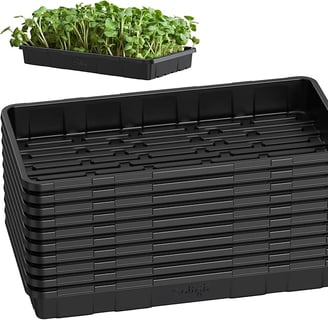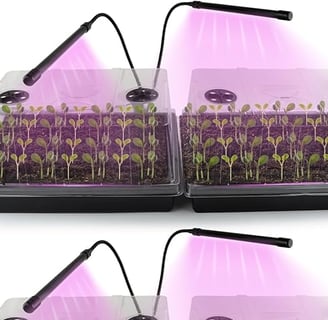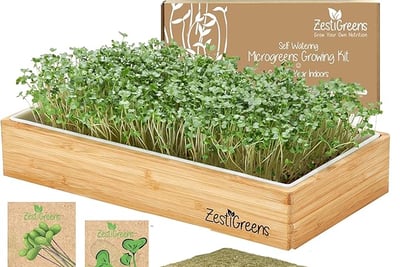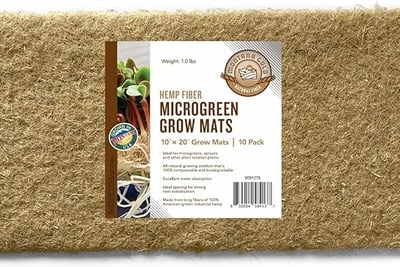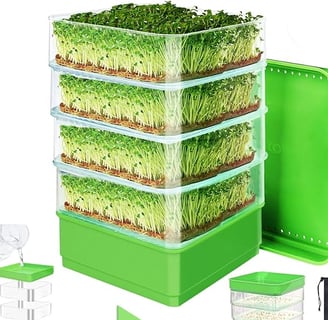Effortless Indoor Microgreens Gardening: A Comprehensive Guide
8 min read


Introduction to Microgreens
Microgreens are young, edible plants that are harvested just after the first true leaves, or cotyledons, have developed. They are typically harvested within 7 to 21 days post-germination, making them an appealing option for those who wish to indulge in a rapid gardening experience. These small but nutrient-dense greens come from various plant families, including herbs, vegetables, and legumes. Due to their concentrated flavor and vibrant colors, microgreens have surged in popularity among culinary enthusiasts and home gardeners alike.
The nutritional benefits of microgreens make them stand out in the realm of gardening. According to various studies, many microgreens contain significantly higher levels of vitamins and antioxidants compared to their mature counterparts. For instance, varieties like broccoli and radish microgreens are known to be rich in vitamins C, E, and K, along with essential nutrients such as glucosinolates, which are beneficial for overall health. Consuming microgreens regularly can enhance one's diet by providing vital nutrients in a small serving size.
In addition to their remarkable nutritional profile, the appeal of microgreens extends to their practicality for indoor gardening. With the rise of urban living and the challenges of limited space, these tiny greens offer an ideal solution for individuals lacking outdoor gardening areas. Microgreens can be cultivated in shallow trays or containers, requiring minimal space yet delivering a substantial yield. This makes them particularly attractive to novice gardeners and those seeking a low-maintenance hobby. Their ability to thrive indoors, often with just natural light or minimal artificial lighting, further enhances their accessibility.
Ultimately, the combination of their nutrient density and ease of cultivation has made microgreens a sought-after choice for home gardeners looking to elevate their culinary creations. The rich flavors and stunning colors of microgreens can transform ordinary meals, adding both visual appeal and exquisite taste to dishes.
Choosing the Right Microgreens
When it comes to selecting microgreens for indoor gardening, the variety you choose can significantly impact both the growing experience and the culinary benefits. Several types of microgreens are particularly well-suited for indoor growing, and popular options include radish, basil, and pea shoots. Each of these varieties not only brings unique flavors to the table but also offers distinct nutritional profiles and ease of growth.
Radish microgreens are known for their crunchy texture and peppery flavor, making them an excellent addition to salads and sandwiches. These microgreens typically grow rapidly, allowing for a quick harvest in as little as 7 to 10 days. Rich in vitamins C and E, radish microgreens also provide a good source of antioxidants, contributing to overall health. Their fast growth and bold taste make them a favorite among indoor gardeners.
Basil microgreens, on the other hand, boast a sweet and aromatic flavor reminiscent of the full-sized herb. These microgreens thrive in well-draining soil and require a bit more light than others. However, their delightful taste and impressive nutritional benefits—such as essential oils believed to reduce inflammation—make them a worthwhile choice for many indoor gardening enthusiasts. Basil microgreens are typically ready for harvest in approximately 14 days.
Pea shoots are another fantastic option, characterized by their tender leaves and mild, sweet flavor. They are incredibly easy to grow and can often be harvested in as little as 10 days after germination. Rich in vitamins A, C, and K, as well as necessary minerals, pea shoots are not only nutritious but also versatile in their culinary uses, pairing well with a variety of dishes, from stir-fries to salads.
In summary, selecting the right microgreens for indoor gardening involves considering taste, nutritional content, and ease of growth. By understanding the unique attributes of radish, basil, and pea shoots, you can better appreciate their varied flavors and health benefits, ultimately enhancing your indoor gardening experience.
Essential Supplies for Indoor Microgreens Cultivation
Growing microgreens indoors is a rewarding and uncomplicated endeavor that requires specific supplies to ensure a successful cultivation experience. The essential materials for this garden setup comprise trays, quality soil, light sources, and effective watering tools that collectively facilitate healthy growth and yield.
First and foremost, selecting the right trays is crucial for cultivating microgreens. Shallow trays are recommended, as they accommodate the growth of these small plants without taking up unnecessary space. Opt for trays with drainage holes to prevent waterlogging, which can lead to root rot. Many growers favor using reusable plastic or biodegradable trays, which are both effective and environmentally friendly.
The choice of soil is equally important, as it serves as the foundation for microgreen development. A quality potting mix that is lightweight and well-draining should be utilized. This type of soil typically contains components such as peat moss, vermiculite, or coconut coir, ensuring adequate aeration and moisture retention. Paying attention to the soil pH is also beneficial, as maintaining a range between 6.0 and 7.0 promotes optimal growth conditions for various microgreen varieties.
In terms of lighting, it is essential to provide adequate exposure to ensure the photosynthetic needs of microgreens are met. Natural sunlight is ideal; however, for those lacking sufficient sunlight, a grow light is an excellent alternative. Full-spectrum LED grow lights replicate natural sunlight and can be easily adjusted to suit the height of the growing plants as they progress through their growth cycles.
Lastly, appropriate watering tools, such as a spray bottle or a watering can with a fine spout, should be employed to maintain moisture levels without oversaturating the soil. Gentle watering methods help ensure that the delicate microgreens do not become uprooted or damaged. Investing in quality supplies not only enhances the indoor gardening experience but also significantly contributes to the health and vitality of your microgreens.
Step-by-Step Guide to Growing Microgreens
Growing microgreens can be an enriching experience, providing a quick and rewarding way to cultivate nutritious greens in your home. The process begins with the selection of seeds. Choose microgreen varieties such as basil, radish, or sunflower, as they are known for their ease of growth and vibrant flavors. It's essential to source high-quality seeds specifically designed for microgreens to ensure optimal germination and growth.
Once you have selected your seeds, the next step is sowing. Begin by preparing a shallow tray filled with a growing medium, such as potting soil, coconut coir, or a seed-starting mix. Evenly distribute your seeds over the surface of the growing medium, then gently press them down and cover lightly with soil. This step is crucial for ensuring that the seeds make good contact with the growing medium, promoting healthy germination.
After sowing, it is vital to provide the right conditions for growing microgreens. Light is a key factor; if natural sunlight is limited, consider utilizing artificial grow lights. Position the lights about 2-4 inches above the microgreens and keep them on for approximately 12-16 hours per day. Watering is equally important, as microgreens require consistent moisture. Use a spray bottle to mist the growing medium daily, ensuring it remains damp but not soggy.
The estimated timeframes for growth vary among different microgreen varieties. Generally, you can expect to see seedlings emerging within 3-7 days, and they can be ready for harvest in about 10-21 days depending on the type. Microgreens should be harvested when they are about 2-4 inches tall, boasting vibrant leaves. Simply cut them just above the soil line using sharp scissors for the best results. Following this step-by-step guide will lead you through a successful indoor microgreens gardening experience.
Caring for Your Indoor Microgreens
Caring for indoor microgreens requires attention to several key factors to ensure they thrive and provide a bountiful harvest. One of the most crucial elements is the light condition. Microgreens need ample light to grow healthily; thus, placing them near a south-facing window is ideal for maximizing exposure to natural sunlight. If natural light is insufficient, using grow lights with a full spectrum can maintain consistent light levels, promoting robust growth.
Next, watering techniques play a vital role in the development of microgreens. It is important to keep the soil moist but not waterlogged. Over-watering can lead to root rot and other detrimental issues. Utilizing a spray bottle for gentle watering can help regulate moisture levels effectively. It is recommended to check the soil daily; if the top inch feels dry, it is time to water. Additionally, ensuring proper drainage by utilizing trays with holes can prevent excess moisture retention.
Another aspect of caring for indoor microgreens is pest management, which can sometimes arise when growing any type of edible plant. Common pests include aphids and spider mites. Regularly inspecting your microgreens and maintaining good air circulation can significantly reduce the likelihood of infestations. In case of a pest issue, employing organic methods such as neem oil or insecticidal soap can provide an effective solution without compromising the safety of your microgreens.
Some common troubles, such as mold growth and brown leaf edges, may indicate improper care. Mold can be caused by over-watering and insufficient air circulation; reducing watering frequency and increasing ventilation can help mitigate this. Brown leaves can result from inadequate light or nutrient deficiencies. Ensuring that microgreens receive adequate light, along with using a nutrient-rich growing medium, will encourage healthier foliage. With these essential care practices, indoor microgreen gardening can become an enjoyable and productive endeavor.
Harvesting and Using Microgreens
Harvesting microgreens at the right time is essential to ensure both maximum freshness and flavor. Microgreens are generally ready for harvest when they have developed their first true leaves, typically around 7 to 21 days after germination, depending on the variety. To harvest effectively, use clean scissors or garden shears to cut the microgreens just above the soil line. This method helps to minimize damage to the roots, allowing for potential regrowth in some types. It is advisable to harvest in the morning when the plants are fully hydrated and their flavor is at its peak.
Once harvested, microgreens can be enjoyed in various culinary applications, making them a versatile addition to meals. Their delicate flavors and vibrant colors make them an excellent choice for enhancing salads, providing a nutrient-dense layer of taste. Moreover, microgreens can be added to sandwiches, tacos, or wraps, adding a fresh crunch and visual appeal. They can also serve as a garnish for soups and main dishes, elevating presentation while contributing nutrition. For those looking to experiment in the kitchen, microgreens can be blended into smoothies, pesto, or used as a topping on pizzas.
To prolong the lifespan of harvested microgreens, proper storage techniques are crucial. Keep them unwashed in a breathable container, lined with a damp paper towel. This method helps to maintain moisture while preventing excess condensation, which can lead to spoilage. Store them in the refrigerator, ideally using a vegetable crisper drawer for optimal humidity levels. When stored correctly, microgreens can last up to a week without a significant loss in flavor or nutrients, enabling their use in various dishes throughout the week.
Conclusion and Additional Resources
Growing microgreens indoors presents a plethora of benefits, making it an appealing option for both seasoned gardeners and novices alike. The ease of cultivation, coupled with the nutritional richness of these tiny plants, creates an enticing opportunity for those looking to enhance their diet or simply enjoy the process of nurturing plants. Microgreens can thrive in small spaces and require minimal resources, making them an environmentally friendly choice as well. With just a few basic supplies, anyone can embark on their indoor microgreens gardening adventure.
As you consider starting your own microgreens journey, remember that the initial investment of time and effort is both rewarding and manageable. Microgreens can often be harvested within two weeks, offering quick gratification and the ability to experiment with various seeds and flavors. This aspect can significantly contribute to problem-solving skills, as you learn to adjust to factors such as light, water, and temperature. Moreover, the inherent variety among microgreens means that there will always be something new to explore and enjoy in your indoor gardening efforts.
For those eager to dive deeper or seeking assistance, a variety of additional resources are available to further enhance your understanding and enjoyment of indoor microgreens gardening. Numerous books delve into advanced cultivation techniques, while online communities can provide support and inspiration. Websites and blogs dedicated to gardening and microgreens can also offer tips, sharing invaluable experiences from fellow gardeners. Engaging with these resources will not only expand your knowledge but also connect you with others who share your passion for growing microgreens indoors.

